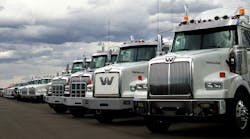There's not a lot of room for equipment “downtime” in the fire and emergency medical response business. Vehicles must be safe and ready to dispatch at a moment's notice when the alarm sounds. Those working for California's Contra Costa County Fire Protection District (CCCFPD) will attest to that. The district responds to tens of thousands of incidents per year.
Based in Concord, CA, CCCFPD serves approximately 544,000 residents within a 350-sq.-mi. area. According to Tim Rau, district apparatus manager, there are 30 firehouses in the district, which encompasses 13 of the county's 18 cities, as well as unincorporated areas.
“Contra Costa,” says Rau, “is one of nine counties in the San Francisco-Oakland Bay area. “At CCCFPD, we place a heavy emphasis on the safety factor of our equipment and keeping them ready to respond to emergencies at all times.”
The district's fire fighting fleet consists of about 100 engines, including basic Type I fire engines and aerial ladder trucks. “We also have large 4WD vehicles for wildland fire response, water supply apparatus trucks for distributing water to areas that don't have fire hydrants, and breathing-support apparatus vehicles that carry compressors to re-supply oxygen tanks,” says Bill Sayre, service coordinator.
According to Sayre, there are currently eight ladder trucks with pumps in the fleet. Called “Quints,” (meaning five), the trucks have a pump, water tank, hose, ground ladders and an aerial ladder, making them capable of performing every job at a fire scene.
“We use different makes of equipment, but our larger pieces are manufactured by KME, Simon Duplex and American LaFrance,” notes Sayre. “The Quints and Fire Engines are powered by Detroit Diesel Series 60 or 6V92 engines, and spec'd with Allison automatic transmissions.”
Rounding out the fleet are Type II, Urban Interface fire trucks (for use where residential homes meet the wildland); Type III, Wildland 4WD fire vehicles; and Type IV vehicles with boost-pumps.
Keeping the fleet safe and operational requires a good maintenance program. CCCFPD has six full-time mechanics and uses RTA fleet management software from Ron Turley & Assoc. to track maintenance on all its vehicles.
“Goodyear tires are another big part of our program,” says Sayre. “We spec Goodyears because they provide us with excellent service and quality products.” The district uses Goodyear's all-position G286, G159 and G149 Series tires on its highway trucks, the new G287 mixed-service tire, and the G164 Series drive tire for on/off-highway applications.
“We replace tires when tread depth reaches 4/32nds,” Sayre explains. “We go by tread depth rather than mileage because we've found wear patterns vary on different vehicles and with different drivers.”
Rau notes there are currently about 400 employees working in the district, 330 of which are firefighting personnel. All of the district's firefighters are also capable of driving the vehicles.
Fire trucks are manned by three-person crews made up of a fire captain, an engineer who drives and operates the pump, and a firefighter. The engineer is also required to perform daily checks of the vehicle chassis, fluid levels, lights, sirens, pump operation and other components critical to the fire trucks' safe operation.
“We do have a few spare rigs,” says Rau, “but these vehicles are very expensive, running as high as $377,000 a piece, so it's not economical to have too many extra units on hand.” All the more reason for CCCFPD to make sure its equipment is kept safe and fully operational around-the-clock.


